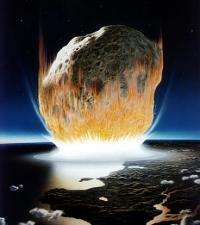A new day dawned fast: Recovery from marine mass extinction happened much faster than thought

(PhysOrg.com) -- In 1979, Luis Alvarez and his collaborators stunned the world with their discovery that an asteroid impact 65 million years ago probably killed off the dinosaurs and much of the the world's living organisms. But ever since, there has been an ongoing debate about how long it took for life to return to the devastated planet and for ecosystems to bounce back.
Now, researchers from MIT and their collaborators have found that at least some forms of microscopic marine life — the so called "primary producers," or photosynthetic organisms such as algae and cyanobacteria in the ocean — recovered within about a century after the mass extinction. Previous research had indicated the process might have taken millions of years.
It has taken so long to uncover the quick recovery because previous studies looked mostly at fossils in the layers of sediment from that period, and apparently the initial recovery was dominated by tiny, soft-bodied organisms such as cyanobacteria, which do not have shells or other hard body parts that leave fossil traces. The new research looked instead for "chemical fossils" — traces of organic molecules (compounds composed of mostly carbon and hydrogen) that can reveal the presence of specific types of organisms, even though all other parts of the organisms themselves are long gone.
The new research, published in the Oct. 2 issue of Science, was led by Julio Sepúlveda, an MIT postdoc who carried out part of the work while still a graduate student at the University of Bremen, Germany, and MIT Professor of Geobiology Roger Summons, among others.
The team had two major advantages that helped to make the new findings possible. One was a section of the well-known cliff face at Stevns Klint, Denmark, that happens to have an unusually thick layer of sediment from the period of the mass extinction — about 40 centimeters thick, compared to the few cm thickness of the layers that Alvarez originally studied from that period at Gubbio (Italy) and Stevns Klint (Denmark). And team members tapped one of the most powerful Gas Chromatograph-Mass Spectrometers (GC-MS) in the world, a device that can measure minute quantities of different molecules in the rock. MIT's advanced GC-MS is one of only a few such powerful instruments currently available at U.S. universities.
When people look at microfossils in the sediments from the period but are unable to detect the chemical biomarkers with the level of sensitivity the MIT team was able to achieve, they "miss a big part of the picture," Sepúlveda says. "Many of these microorganisms" that were detected through molecular signatures "are at the base of the food chain, but if you don't look with biochemical techniques you miss them."
The analysis clarified the sequence of events after the big impact. Immediately after the impact, certain areas of the ocean were devoid of oxygen and hostile to most algae, but close to the continent, microbial life was inhibited for only a relatively short period: in probably less than 100 years, algal productivity showed the first signs of recovery. In the open ocean, however, this recovery took much longer: previous studies have estimated that the global ocean ecosystem did not return to its former state until 1 to 3 million years following the impact.
Because of the rebound of primary producers, Sepúlveda says "very soon after the impact, the food supply was not likely a limitation" for other organisms, and yet "the whole ecology of the system remained disrupted" and took much longer to recover.
The findings provide observational evidence supporting models suggesting that global darkness after the impact was rather short. "Primary productivity came back quickly, at least in the environment we were studying," says Summons, referring to the near-shore environment represented by the Danish sediments.
"The atmosphere must have cleared up rapidly," he says. "People will have to rethink the recovery of the ecosystems. It can't be just the lack of food supply" that made it take so long to recover.
The team hopes to be able to study other locations with relatively thick deposits from the extinction aftermath, to determine whether the quick recovery really was a widespread phenomenon after the mass extinction.
These findings seem to rule out one theory about how the global ecosystem responded to the impact, which held that for more than a million years there was a "Strangelove ocean" — a reference to the post-apocalyptic scenario in the movie Dr. Strangelove — in which all the primary producers remained absent for a prolonged period, Summons says.
Provided by Massachusetts Institute of Technology (news : web)


















